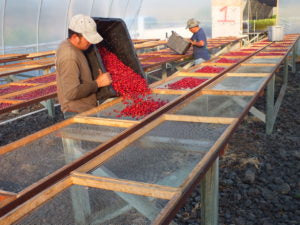Is Laser Brewing Next?
It's fascinating to see how coffee brewing has evolved over the centuries. Coffee was originally brewed by pouring hot water over whole coffee fruit. Later, this evolved into roasting the whole fruit and crushing it before the hot water was added. The mixture was not filtered, instead the slurry was allowed to settle before drinking. Early coffee aficionados who had a full set of teeth to filter the slurry had an advantage over less fortunate drinkers. Coffee brewed this way is called “Quarsh” and is still served in some countries.
Arabic coffee drinkers improved brewing by removing the fruit and just roasting the bean. Today we have Turkish coffee, where fine ground beans are brewed over a hot brazier with copious amounts of sugar. The slurry is allowed to settle and then the brew is descanted attempting to leave the grounds in the bottom of the brew pot. However, a full set of teeth is still an advantage.
Brewing coffee grounds in cloth bags in boiling water or at least filtering the coffee grounds through clth bags was the next step in brewing technology. At least through the beginning of the 19th century, this was the western standard for brewing coffee. Then in the early 1800’s a new brewing method was introduced. Melitta Betz tore a page out of her son’s copy book, made a funnel, poured ground coffee into it, and then hot water. She, thereby, created the first pourover coffee and thousands of barista jobs.
Also, in the 1800’s, Loeff of Berlin invented the siphon coffee maker. Even though siphon coffee makers sucked, they were the standard method of brewing coffee in shops and restaurants until the 1950’s.
Also in the late 1880's an Illinois farmer invented the percolator. While he designed the brewer for home use, large percolators were created for commericlal use. The large percolators are still in use in some retaurants and cafes.
Using similar technology to the percolator, moke pots were introduced in Europe in the early 1900s. Their advantage was that they did not recirculate the coffee avoiding over extraction and bitterness.
At mid-20th century, Mr. Coffee introduced the automatic pour over coffee brewer, which knocked out the siphon brewers from the cafes and restaurants.
Another brewing method emerged around the mid-20th century, the French Press. Everyone has a French Press in their home; it is stored in the back of the closet next to the fondue pot. However, you are not likely to find a French Press in a French closet, the French drink espresso.
Today, all these brewing methods have been largely supplanted by two other brewing methods 1) instant coffee and 2) capsule brewing. Convenience has replaced quality. The number one and two coffees sold in the world today are Nescafe and Nespresso instant coffee.
Home and restaurant brewing is dominated by capsule brewers. If you order coffee or an espresso in a five-star restaurant, there is a high probability that the waiter will just put a Nestle capsule into a brewer and charge you $15.00.
So, what is the future? Microwave coffee is a possibility. Consumers often reheat brewed coffee in a microwave. While microwaving is a quick way to reheat coffee, it can alter the taste and aroma slightly compared to other methods like using a stovetop or electric kettle. However, trying to brew coffee in a microwave is dangerous. If microwave brewers could control the amount of power to keep the slurry from exploding or boiling over, it could be done, but we are not there yet.
Another possibility is laser coffee brewing. There have been some experimental and novelty approaches to using lasers in coffee preparation. One such method involves using lasers to heat the water quickly and precisely. Laser technology can be used to focus a high-intensity laser beam into the water to rapidly heat it to the desired temperature for brewing. This method could potentially offer precise control over the water temperature, which is crucial for brewing different types of coffee beans.
A recent science experiment used lasers to create ultrafast cold brewed coffee. Normally, cold brewed coffee takes several days to brew. However, by blasting the grounds in cold water with short laser pulses the cold coffee can be brewed in a matter of minutes without heating the water. Ultrafast cold-brewing of coffee by picosecond-pulsed laser extraction Science of Food volume 6, Article number: 19 (2022)
Whatever brewing methods are in the future, the problem will always be how to offer convenience and still maintain quality. Until then coffee gourmands who want flavorful coffee will just have to spend the extra time

